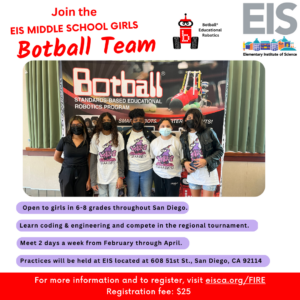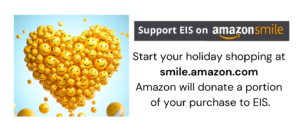Martin Luther King Jr. Activities
Elementary Students Are Having Fun Learning Math with Origami through VisMO
 Fourth and fifth-grade students in EIS’s Steps-2-STEM program are learning math through origami – bringing math to life with fun hands-on paper folding lessons. VisMO is an origami-based program that examines the relationship between elementary school students’ visuospatial reasoning and their mathematical skills. Visuospatial skills refer to a person’s visual and spatial awareness. For example: What is the orientation of your paper? What is your spatial relationship to other objects in the room?
Fourth and fifth-grade students in EIS’s Steps-2-STEM program are learning math through origami – bringing math to life with fun hands-on paper folding lessons. VisMO is an origami-based program that examines the relationship between elementary school students’ visuospatial reasoning and their mathematical skills. Visuospatial skills refer to a person’s visual and spatial awareness. For example: What is the orientation of your paper? What is your spatial relationship to other objects in the room?
Instructors from the Jacobs Institute for Innovation in Education at the University of San Diego engage students in mathematical thinking and real-world applications of mathematics beyond just numbers. For example, students visualize folding transformations with their mind’s eye, make conjectures, and justify their reasoning. In that process, they also go through a productive struggle and learn that this experience helps them develop neural connections that strengthen their mind.
EIS students are enjoying the program; two-thirds of the students shared that it helped them feel better about mathematics. One student commented: “I learned that I can explore my mind,” and another “learned that math can be ok if [they] stay confident.” In the last three years, over 700 students in San Diego and Los Angeles counties have participated in Project VisMO. Research suggests students have lower mathematics anxiety and an increase in spatial vocabulary skills.
 VisMO was developed through a National Science Foundation funded research project. The curriculum was created through the collaborative effort of cognitive psychologists, learning scientists, mathematics education researchers, and origamists at the Jacobs Institute for Innovation in Education at the University of San Diego, the University of Michigan, and the University of Missouri. Locally it is managed by Rebecca Ottinger, VisMO Project Manager at the Jacobs Institute for Innovation in Education she/her/hers, and Perla Myers, Executive Director at the Jacobs Institute for Innovation in Education, she/her/ella
VisMO was developed through a National Science Foundation funded research project. The curriculum was created through the collaborative effort of cognitive psychologists, learning scientists, mathematics education researchers, and origamists at the Jacobs Institute for Innovation in Education at the University of San Diego, the University of Michigan, and the University of Missouri. Locally it is managed by Rebecca Ottinger, VisMO Project Manager at the Jacobs Institute for Innovation in Education she/her/hers, and Perla Myers, Executive Director at the Jacobs Institute for Innovation in Education, she/her/ella
Learn more at ProjectVisMO.com.
Why Volunteer as a Lab Assistant at EIS?
At EIS, giving youth opportunities to explore STEM careers is an important part of our work. This month we are happy to share the experience of a teen volunteer in our lab assistant program. Lab assistants are school students who assist EIS Instructors, serve as positive role models to students, improve their own STEM content knowledge, and earn volunteer hours.
My name is Catalina. I am currently 16 years old, and recently interned for EIS during Spring Break. I found it was a wonderful opportunity to see what I would like to do in the future, and I am writing this, in an effort to convince others what a positive experience it is!

To start this off, though—why would you want to be a lab assistant, during your precious Spring Break? For one, the benefits of this program far outweigh the con of having one less week off—especially comparing it to post-graduation, when organizations would want interns to stay for longer periods of time (such as a month!). Another major benefit is being able to find what you like to do—be it helping teach STEM courses, assist children, or just gain experience working in a professional setting! EIS is, in my opinion, the place to be, when interning as a High-school student—the staff are supportive of their organization’s interns, give plenty of fun activities for you to do, along with the class, and have reasonable expectations for work hours and performance!
Another important detail is that, once you complete the internship, you can list this on your resume—something that really stands out to the colleges you will eventually be applying to! This week would be a time to try out something you may or may not be interested in. If you enjoy it, that’s wonderful! If not, you don’t have to spend a second week on it! As someone who worked with EIS, and a high-school student, getting ready to apply for college, I urge you to try this program! It’s a great opportunity, and one I’m sure is worthwhile!
Discover how to be a Lab Assistant at https://eisca.org/lab-assistant/
Sign Up for EIS Botball

Learn more and sign up: eisca.org/fire
The Mathemagician Homework Club Return October 1st!
 If you would like to participate, email info@mathemagiciansclub.com. Include your email, your child’s grade, and math concepts they are working on (or share an attachment of their homework). Mentors will offer help, more practice problems or worksheets. This includes SAT math help as well. They will monitor this email daily so you don’t have to wait until Saturday to ask for help.
If you would like to participate, email info@mathemagiciansclub.com. Include your email, your child’s grade, and math concepts they are working on (or share an attachment of their homework). Mentors will offer help, more practice problems or worksheets. This includes SAT math help as well. They will monitor this email daily so you don’t have to wait until Saturday to ask for help.
The Mathemagicians App is here! In addition to joining the Mathemagicians every Saturday for math tutoring, students can now practice math on the new app. It’s available for free at the “Apple App Store” for download. https://apps.apple.com/us/app/mathemagicians/id1557607923

Have you participated in programs or volunteered at the Elementary Institute of Science?
Whether you’re still in high school, college, working or retired, we want to know what you’ve been up to and if you have thoughts about any impact EIS had on your life or career. Please send an email to our Development Assistant, Leah Oviedo at loviedo@eisca.org.
EIS alumni are invited to join our official group to reconnect and stay updated on future reunions. Facebook.com/groups/AlumniConnectEIS





